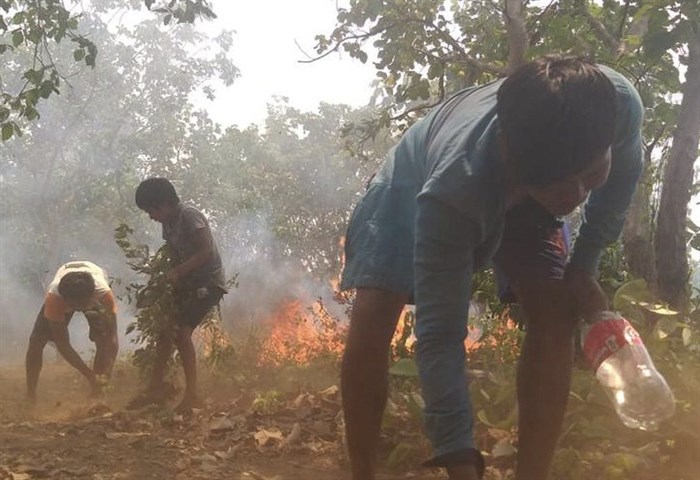
Indigenous fire practices like cultural burning may become funded through an international climate fund following the ratification of a biodiversity framework Thursday.
Image Credit: Photo courtesy Avaaz
August 27, 2023 - 11:30 AM
Indigenous Peoples demanding access to the Global Environment Facility (GEF) welcomed the target set Thursday by the international council to fund Indigenous practices as part of the ratification of the Global Biodiversity Framework Fund (GBFF).
Environment and Climate Change Minister Steven Guilbeault announced Canada will contribute $200 million to the fund, with 20 per cent allocated for Indigenous Peoples. Prior to the GBFF ratification, Indigenous Peoples were demanding direct access to 20 per cent of the GEF fund in order to fund the autonomous management of their territories’ biodiversity, and now, for the first time, will have access to international climate funds.
However, there are lingering concerns that the language of the framework, which cites the 20 per cent for Indigenous Peoples goal as “aspirational,” could limit Indigenous access without a fixed funding target. Canada’s leadership in advancing Indigenous access to funds is positive, but without the assured language, other countries might not necessarily follow Canada’s steps, Oscar Soria, campaign director for activist group Avaaz, told Canada’s National Observer.
The word “aspirational” in diplomacy terms is what Soria refers to as “constructive ambiguity.” Soria explains it like this: Say you and a friend go to the cinema and you want to see Barbie, while your friend wants to see Oppenheimer. Under constructive ambiguity, both of you would only decide together to go to the cinema to see an American movie, but a real decision will not be made until you reach the ticket booth.
“Basically, it serves a purpose today, but not tomorrow,” he said.
“You also have that situation in which sometimes the funds are awarded not based on merit, but based on politics,” he explained.
Indigenous Peoples and their ancestral practices of sustainable land management, such as Indigenous fire practices, can help manage biodiversity and ecosystems, according to a recently published discussion paper released by Avaaz arguing for Indigenous funding.
Those fire practices, seen as a beacon of hope during the global wildfire crisis that has been stoked by human-caused emissions, can help reduce the severity of wildfires and promote biodiversity if given the funds and autonomy to do so, the discussion paper said.
“It is clear that even though a global assessment on costs is not currently available, the unparalleled value of Indigenous knowledge in fostering resilient ecosystems is still underestimated by governments, financial institutions and non-governmental organizations,” the discussion paper reads.
Money has always been used to weaken the power of Indigenous Peoples throughout the braided history of capitalism and colonization, Darío José Mejía Montalvo, former chairperson and current member of the UN’s Permanent Forum on Indigenous Peoples, told Canada’s National Observer.
“Money is an instrument, a tool,” he said through a translator, pointing to how money has been historically used to dismantle Indigenous Peoples’ territories and knowledge systems.
Indigenous Peoples manage their territories much differently than how markets have managed the ecosystem, which has often prioritized extraction, Montalvo explained.
“That is why it's important that if there is going to be some financing, it has to come aligned with another way of thinking. Not the way that the market is used to do it. That has resulted in destruction,” he added.
Montalvo says the monetary system must change to meet today’s needs, which he emphasized is the autonomy of Indigenous Peoples to manage their territories.
Autonomy could act as a North Star for human societies, demonstrating alternative ways to manage lands and communicate with the planet.
“We Indigenous Peoples do not impose the rules, we listen to the rules of nature,” he said.
However, more autonomy for Indigenous Peoples living within state borders remains a tension, especially for land management and fire practices. For example, in Canada, burns used for wildfire management must be approved by provincial ministries, often through paperwork and under the supervision of forest firefighting organizations. Without ministerial approval, an Indigenous person practising cultural burns can be held criminally liable.
Ancestral territories of Indigenous Peoples also often overlap with Crown land, a jurisdiction of the provinces, which at times infuses conflict between Indigenous-driven and market-driven land management.
The discussion paper voices urgency in combating the interwoven biodiversity and climate crisis. In B.C. alone, the average amount spent fighting forest fires is $317 million a year, eclipsing the $200 million Canada pledged to the biodiversity framework fund on Thursday.
“These extreme events, in reality, is the language the planet is using to ask for help,” Montalvo said.
— With files from John Woodside
— This story was originally published by Canada's National Observer
News from © iNFOnews, 2023